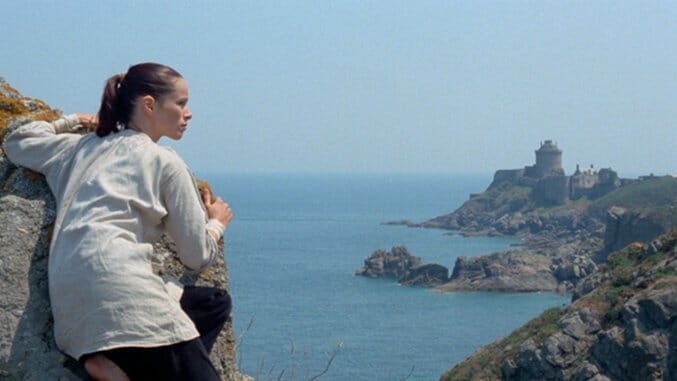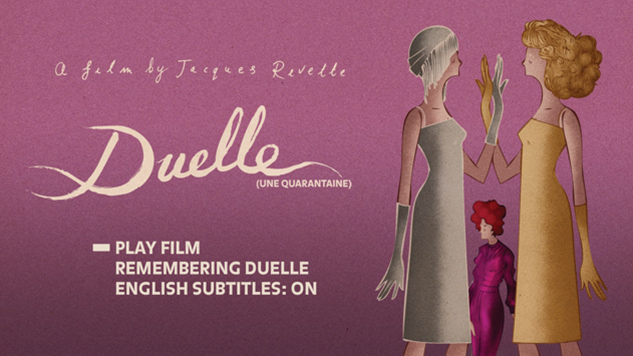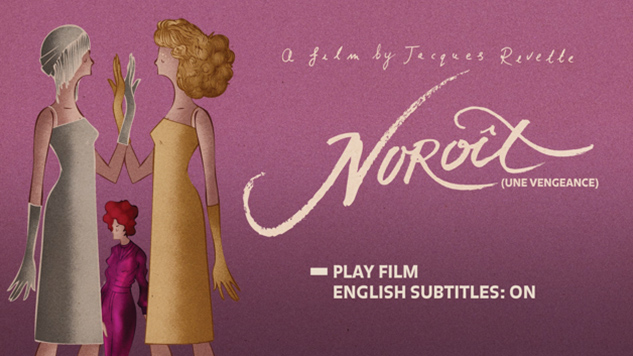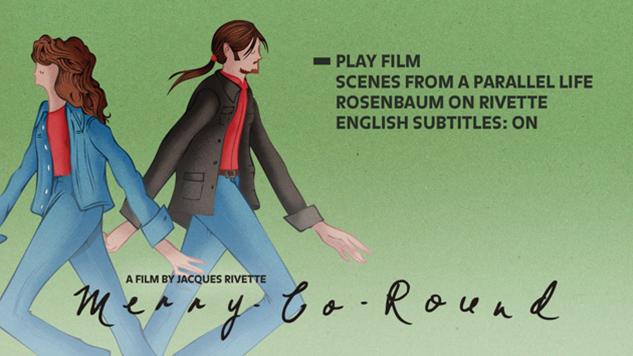Jacques Rivette Goes Boating: The French Legend’s Forgotten Masterworks
Stills: Arrow Academy Movies Features Jacques Rivette
Was Jacques Rivette the heart of the French New Wave, or its appendix?
As Samuel Wigley wrote following the filmmaker’s 2016 death, Rivette’s “stock is perhaps the highest of all the new wave directors.” Famously, in 1963, he became editor-in-chief of Cahiers du Cinema, the film criticism magazine that launched the profiles of Éric Rohmer, Jean-Luc Godard and François Truffaut. Then in 1971, he wrote and directed Out 1 (currently available on Netflix), a made-for-television opus that has become equally legendary for its aesthetic magnificence as for its outrageous 13-hour run-time.
That film and its shortened version, Out 1: Spectre, have in recent years resurfaced in screenings around the world, and become among the era’s most respected works. Yet neither as prolific as Godard nor as famous as Truffaut, Rivette is still remembered primarily for his 60-year career’s slim catalogue of minor hits like Celine and Julie Go Boating and La belle noiseuse.
It is with perfect timing, then, that Arrow Academy last month released The Jacques Rivette Collection Limited Edition, a Blu-ray box set that challenges the misguided obscurity of Rivette’s mid-career productions. With luxurious new sleeve art by Ignatius Fitzpatrick and sumptuous 2k restorations of three long-forgotten wonders—Duelle, an influential modern fairytale; Noroit, a Brittany-shot experimental pirate revenge drama; and Merry-Go-Round, which helped Rivette recover from nervous collapse—the box set suggests that footnoting the filmmaker into cinema history is no longer possible, that these abandoned masterworks have left their visual imprints on everything from David Lynch’s movies to Pirates of the Caribbean.
Duelle (une quarantine) (1976)

Jonathan Rosenbaum, Rivette’s most devoted acolyte, writes that “all of his first six features take place in a sharply perceived environment that can arguably be called the ‘real world’.” Rosenbaum’s assessment is accurate, but misleading. In fact, titled Twhylight in North America following its 1976 Cannes Film Festival premiere, the sixth of these films contorts the concept of reality to an almost Buñuelian degree.
Juliet Berto and Bulle Ogier star respectively as Leni and Viva, immortal femmes fatales whose increasingly violent confrontations within contemporary Paris center on a fantastical diamond. The jewel brings coveted mortality, but those who touch it suffer excruciating pain. The goddesses must manipulate others into stealing it for them.
Such machinations ultimately force Lucie (Hermine Karagheuz, a magnetic Rivette stalwart), an innocent hotel porter, her lothario brother Pierrot (dancer Jean Babilée) and his sex-worker mistress Elsa (French filmmaker Nicole Garcia) into an amateur treasure hunt.
Viva, “the Queen of the Sun,” and Leni, “The Queen of the Night,” are two of Rivette’s most inspired—and, appropriately, his most commonly mimicked—creations. In classical dramatic form, even immortal women are forced to face the humiliations and trials of 1970s France in flux. Leni’s costuming and makeup expertly reflect her darkened, occult palette, the supernatural inversion of famously spider-like seductresses in classic films noir (think Barbara Stanwyck in Double Indemnity). One might call her the Goddess of Punk.
Viva is a formidable counterpart, a slyly mischievous Loki character with cloning abilities and a penchant for billiards. With her blonde hair, blue eyes and Nightcrawler-style teleportation, Ogier is the French predecessor to Laura Palmer’s Red Room doppelgänger in Twin Peaks.
Ultimately, as David Lynch, Peter Greenaway and many others would later, Rivette violates strict formal rules in Duelle regarding characters’ physical impermanence, as well as with several highly abstract sequences in which he manipulates film stock, color and aspect ratio. These kinetically disjointed sections, where actors perform Babilée’s frantic choreography amidst unspecified times and places, remain inimitable. Though his approach referenced “a tradition of French fantasy” led by Jean Cocteau and Georges Franju, Rivette’s vision went, as Rosenbaum notes, “far beyond allusions.”
Noroît (une vengeance) (1976)

Duelle, groundbreaking as it is, was not made in isolation. Rivette and producer Stéphane Tchalgadjieff conceived it as part of a tetralogy that also included Noroît (une vengeance), the most challenging work in the collection. Released in English as Nor’wester, this drama is the most avant-garde pirate epic ever filmed: part The Tempest, part Frankenstein homage and part existentialist Antonioni riff.
Perhaps because it is a hodge-podge of disparate influences, Noroît never coheres as an adaptation of Thomas Middleton’s 1606 play The Revenger’s Tragedy. In Rivette’s version (which he co-wrote with his wife, Marilù Parolini, and Eduardo de Gregorio), Morag (Geraldine Chaplin, aggressively brilliant) schemes to murder pirate queen Giulia (Bernadette Lafont, in bubble-gum pink jumpsuits), who killed Morag’s brother. Aside from its Shakespearean five-act structure, however, the picture is mostly composed of brutal dialogue-free tete-a-tetes between Morag and Giulia’s band of louche vagabonds.
Unmoored from narrative storytelling conventions, Rivette guides the film toward an expressive spontaneity and beauty of which few theatrical adaptations can boast. Between the two leads and Giulia’s lieutenant Erika (Kika Markham), he concocts a psychosexual triangle of mistrust, intimidation and attraction, the actors’ balletic body language alluding to classic scenes in Cocteau’s The Blood of a Poet and Maya Deren’s Meshes of the Afternoon.
These days, the pastel-inflected fantasy world created by William Lubtchansky’s lush cinematography and Eric Simon’s expressionist production design will most strongly resonate with anyone familiar with Wes Anderson’s colorful The Grand Budapest Hotel miniatures. Only Rivette, though, could have made a cinema-play so stunning that Hollywood would later imitate it with a pirate revenge franchise.
Merry-Go-Round (1981)

If Noroît is this collection’s most inscrutable work, Merry-Go-Round is its most classically accomplished, an expert slow-burn kidnapping thriller garnished with Surrealist and Pop imagery.
Maria Schneider (Last Tango in Paris) stars as Léopoldine, whose heiress sister (Danièle Gégauff) may have been kidnapped by her psychiatrist. In a fit of coincidence, she encounters Ben (Warhol favorite Joe Dallesandro, in his strongest leading role), a stubbly charmer with a conniving streak. Again, Rivette sustains an elaborate dynamic of repulsion and desire, this time aided by Schneider’s delightfully Bogart-like cynicism and Dallesandro’s legendary allure.
By hiring Schneider and Dallesandro, the filmmaker tapped into the stars’ provocative countercultural associations: Schneider with Bernardo Bertolucci, who last year confessed to forcing the actress to perform rape scenes; and Dallesandro with Warhol’s underground cinema collective. The script uses these affiliations to shroud the characters with mystique, shifting the viewer’s allegiances with each disquieting revelation and creating a masterwork so unceasingly entertaining that it never goes slack across nearly two-and-a-half hours.
Why, then, is Merry-Go-Round so widely forgotten outside of the filmmaker’s cult following? As Rivette explains in Parallel Life: Jacques Rivette Remembers (from the box set), his aim following a breakdown was to stray from the increasingly common political dramas of his New Wave peers. This kind of film was simply out of vogue by 1981. By eliding obvious ironic symbolism or a direct critique of his environment in Merry-Go-Round, Rivette smartly positioned the film as an esoteric counterpart to Out 1. Make no mistake: Neither this Shyamalan-ian thriller nor the other films in the collection seem abstruse by comparison anymore.
Seen together, these movies mesh into a powerful alloy of abstraction and narrative, reality and fantasy, beauty and grimness. Rivette’s singular creative risk-tasking, which in its time must have felt inscrutable, now seems genius.